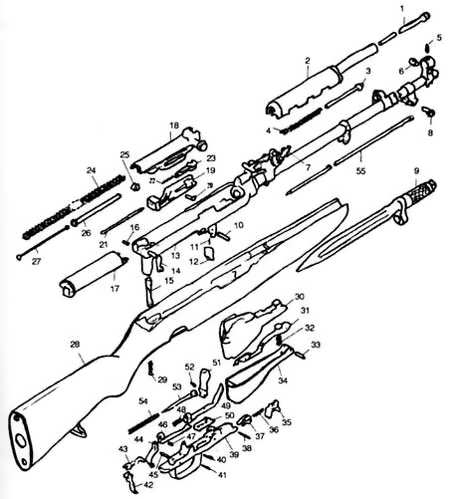SKS (Semi-) Automatic Carbine Hunting Rifle
Instruction Manual

SKS semi-automatic Carbine hunting Rifle. Russian Rifle. Description, technical characteristics, rules of operation, passport, manual
The information included in this section is drawn from official manuals
SKS - (Samozaryadnii karabin Simonova) Simonov self-loading carbine
Use of material is possible with active link
© 2015-2023. Hunting, Fishing - Information Portal
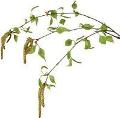
.jpg)
7.62x39mm Rifles
Instruction Manual for Shooting & Maintenance
Table of Contents
Warnings and Disclaimers 1
History of the SKS 2
Safety Guidelines 3
Operative Cautions 4
Specifications 5
Main Parts and Accessories 6
Loading the SKS 7
Unloading the SKS 8
Disassembly/Assembly 9
Cleaning Procedures 10
Removing Trigger Mechanism/Magazine 11
Removing Receiver Barrel Assembly from Stock 12
Sight Adjustment 13
Mounting the Bayonet 14
Parts Legend 15
Exploded View of Gun 16
Important: Warnings and Disclaimers
Warning:
Careless use of any firearm can be dangerous. The warnings and instructions in this manual should be read thoroughly so that you might fully understand how to properly use your SKS rifle. Accidental discharge can occur from careless handling and could cause serious injury, death or damage to property. SKS RIFLES SHOULD BE CLEANED THOROUGHLY PRIOR TO USE.
Danger- Ammunition Warning:
Use only 7.62x39mm Soviet ammunition in your SKS rifle. Never attempt to use ammunition of any other calibre in your gun. Use only newly manufactured ammunition that is of high quality and in good condition. Never use "remanufactured" or hand-located (reloaded) ammunition or ammunition that is faulty, incorrect or nonstandard, as both the manufacturer and the importer of this firearm specifically disclaim responsibility for any damage or injury whatsoever occurring in connection with or as the result of the use of such ammunition with this firearm.

History of the SKS
The concept of the Assault Rifle began with the Soviets in the early 19900's. Later, during World War 1 Vladimir Fedrov introduced the Federov 1916 Automatic Rifle, which fired a 6.5x50.5SR Japanese cartridge. At this time this cartridge was thought to be the best for use in rapid firing rifles. These guns were used toward the end of the 1914-18 war and the Russo-Finnish war of 1939-40.
During World War II, the Russians' need for the "Avtomat" increased, and they adopted use of a 7.62x39mm cartridge. Te weapon created by S.G. Simonov to fire this cartridge was the SKS-45, (Samozaryadni Karabin Simonova) a self-loading carbine, which was a scaled-dawn version of the 14.5x111.8mm PRTS anti-tank rifle. The SKS-45 was easy to field strip and maintain and was quite popular.
At this same time, M.T. Kalashnikov was working on designing a series of small arms, which would also use the 7.62x39mm cartridge. He was successful, and developed one of the best known military weapons of our time, the AK-47 (Avtomat Kalashnikova) in 1947. The AK-47 was the prototype for many subsequent versions, and the Chinese manufactures SKS Type 56 rifle is a direct derivative of Kalashnikov's design.
At the convulsion of World War II, the People's Republic of China inherited many of these Soviet weapons from the Japanese. (The Japanese had seized them in Manchuria.) During the Chinese Civil War, the PRC began making this equipment, and by war's end were well on their way to standardizing production of these Soviet-type small arms.
In recent years, the People's Republic of China has been producing the 7.62x39mm Type 68, the 7.62x39mm Type 67, the 7.62x25mm Type 64, and the SKS Type 56 with the distinguishing folding bayonet. The SKS Type 56 was encountered frequently during the Vietnam War.
As a military weapon, the SKS rifle is only used by frontier forces, however it remains ever popular with the American sportsman as a hunting weapon, and as always with collectors and firearms enthusiasts.
Safety Guidelines for Proper Operation of Firearms
1. Always treat a firearm as if it were loaded. Accidents happen when it is "alleged" that the weapon is unloaded.
2. Keep the muzzle of the firearm pointed toward a safe direction at all times. Never point a weapon at anything you do not intend to destroy!
3. Never rely exclusively on your gun's safety mechanism. It is only an aid to safe gun handling, but it is a device which could fail or be inadvertently disengaged.
4. Check to see that the barrel is free of obstructions before firing. Remove all grease, oil, or other debris to prevent the barrel from rupturing upon firing. Check the bore, the chamber, the magazine assembly.
5. Be absolutely certain of your target and the backstop. Make sure your backstop is sound, and to prevent ricochet, never shoot at hard objects or water.
6. Always wear shooting glasses and ear protection while shooting.
7. Understand the operating principle of the firearm and become familiar with its handling characteristics before attempting to use it.
8. Be certain you are using the correct ammunition. Use only high quality military or commercial ammunition. Do not use reloaded or handloaded cartridges.
9. Keep the firearm unloaded when it is not in use. Store ammunition separately from the gun. Do not transport a loaded weapon.
10. in case of failure to fire, always keep the muzzle pointed in a safe direction and hold the firearm in this position for 30 seconds. After 30 seconds, remove the magazine, open the action, and retrieve the cartridge.
Test Your Gun:
1. Load two rounds of ammo into the magazine.
2. While in a stable firing position, point the muzzle downward.
3. Pull the charging handle or slide back, and let it fly forward to chamber the first round.
4. If your weapon fires, stop firing and unload weapon. (This is called a "Slam Fire")
5. If there is no "Slam Fire", aim the weapon and pull the trigger.
6. If both rounds fire with one pull of the trigger, stop firing. (This is called "Doubling")
7. Either situation is dangerous, and the gun should not be fired. Take the weapon to a gunsmith or place of purchase.
Cautions.
1. Do not allow rifle to be heated or sunburnt.
2. Frequently lubricate your weapon.
3. Frequently clean your weapon. Particularly the gas system and bore. Always cover with a light coat of gun oil after cleaning.
4. When storing, always keep the hammer in its released position.
Thoroughly Clean your SKS Rifle Prior to Use!
Specifications
SKS Type-56
Calibre 7.62mm
Weight 8.4lbs (approx)
Length 40.20 inches
Barrel 20.5 inches, 4 groove, R.H. Twist
Muzzle Velocity 2,410 f.p.s
Magazine 10-round fixed box
Aiming Range .621 mile, 1 kilometer
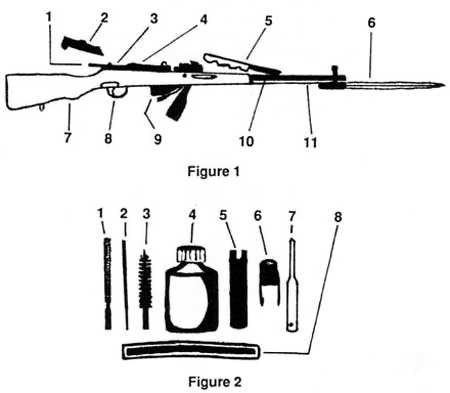
The SKS Rifle consists of 11 Main Parts (see Figure 1)
1. Recoil Spring Assembly
2. Receiver Cover
3. Receiver
4. Bolt
5. Gas Tube/Handguard Assembly
6. Bayonet
7. Stock
8. Trigger Group
9. Magazine
10. Barrel
11. Cleaning Rod
The Basic SKS Accessories (see Figure 2)
1. Cleaning Rod Head
2. Drift
3. Brush
4. Oil Can
5. Accessory Case
6. Muzzle Cap
7. Gasport Cleaning Tool
8. Clip
It will be helpful to refer to the parts described and as shown on these two pages when following the instructions in this manual.
Loading the SKS
Instructions for Loading
(Always Remain Conscious of Muzzle Position!)
1. Flip the safety to the "ON" position (see Figure 3)
2. Pull charging handle on bolt carrier back until the action locks open.
3. Load with either single rounds or stripper clips (see Figure 4)
4. Again, remain conscious of muzzle position.
5. Pull charging handle back and let the bolt carrier fly forward to chamber the first round.
6. Your rifle is now loaded.
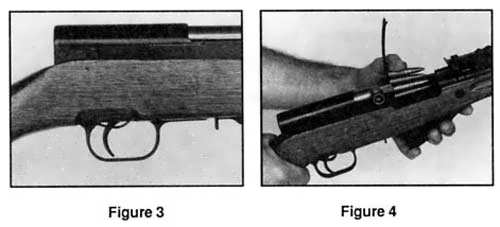
Instructions for Firing SKS
(Always Remain Conscious of Muzzle Position!)
1. Aim your rifle downrange.
2. Release the safety.
3. Place finger inside trigger guard on the trigger.
4. Pull the trigger back.
Unloading the SKS
After Firing
(Always Remain Conscious of Muzzle Position!)
When the gun is fired, gas pressure is extracted from the spent cartridges, and they are ejected. New rounds are then automatically fed until all the rounds are gone, or the shooter stops firing. When finished firing, lock back the bolt and always engage the safety before unloading unused cartridges.
Instructions for Unloading
(Always Remain Conscious of Muzzle Position!)
1. If bolt was locked back, rifle should be unloaded.
2. Visually inspect the magazine and chamber to confirm that the gun is empty.
3. If unsure whether empty, immediately place the safety in the "ON" position.
4. Release the magazine cover by pulling back the magazine cover latch. (see Figure 5)
5. Any unexpended rounds will now be freed from the magazine.
6. Now, lock the magazine cover back in place.
7. Next, pull back the charging handle to the rear and extract and eject the live round in the chamber. The bolt stop will automatically lock the bolt carrier back (see Figure 6)
8. Again, visually inspect the weapon.
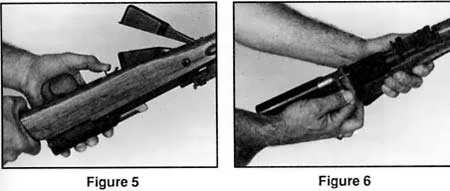
SKS Disassembly/Assembly
Make a safe examination of the rifle to be certain it is not loaded before stripping. Open the magazine cover, draw back bolt and lock into magazine and chamber to be certain they are empty.
Instructions for Disassembly/Assembly
1. Take out all accessories. With a finger, press in the cover of the accessory chamber on the butt plate and take the case for accessories out of the stock. (see Fig 7) Open the case and take out the accessories.
2. To remove the cleaning rod: swing the bayonet outward from the muzzle of the rifle and remove the cleaning rod. Then, fold the bayonet back to a "march position."
3. To remove receiver cover and recoil spring assembly: hold the small of the stock with your left hand, pressing with your thumb on the rear of the receiver cover (see Fig 8); rotate with the right hand the receiver cover retaining pin arm upward to its vertical position and pull the pin out to the right as far as possible. (See Fig 9) Allow receiver cover to move backward ?" and remove the sliding to rear. (See Figure 10) Remove the recoil spring from the rear of the bolt carrier. (See Figure 11) (Be certain to reinstall recoil spring with C Clip end forward.)

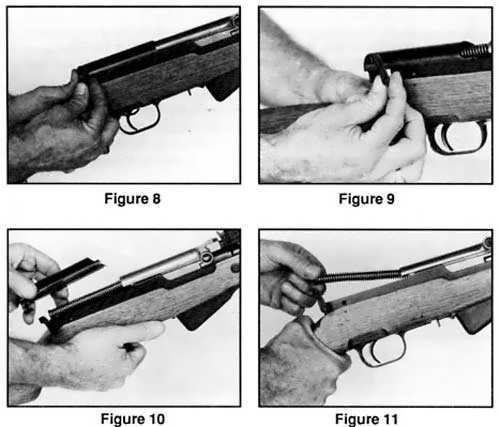
4. To remove the bolt: pull the bolt back as far as it will go, and remove the entire assembly. (See figure 12) When reinstalling bolt, be certain magazine cover is not latched.)
5. To remove Gas Tube/Handguard Assembly: use a pin punch to pry a lever located on right of rear sight base into the position where the camming surface located at the front is completely vertical (See figure 13). CAUTION: Further movement will allow operating rod and spring to escape.
6. Now remove the Gas Tube/Handguard Assembly, raise the handguard assembly and rock it slowly from side to side until it can be pulled away from the gas block. (see figure 14)
.jpg)

7. The gas piston can now be pulled out of the gas tube/handguard assembly.
NOTE: The seven steps listed are sufficient to field-strip the rifle for cleaning and regular maintenance.
Assembly Requires only that you Perform the Above Steps in Reverse Order.
Cleaning the SKS
Make a safe examination of the rifle to be certain it is not loaded before cleaning. To clean, begin with the rifle field-stripped.
Instructions for Cleaning the Rifle SKS
1. Attach the bore brush to the cleaning rod.
2. Saturate the bore brush with gun solvent and push through the length of the barrel (see Figure 15). If using corrosive primer, this step is very important to remove the corrosive residue from the barrel of your rifle.
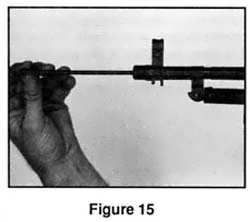
3. Make at least 10 passes through the barrel from the muzzle end. The cap of the accessory tube can be used to protect the crown of the muzzle from damage during cleaning. Use a cleaning jag or slotted tip and push a clean dry patch through the bore. Now pass a clean patch soaked with solvent through the bore. Alternate this procedure with wet and dry patched until the patched come out clean.
Before firing, check the bore for obstructions.
4. Dry the bore with a clean dry patch, and then apply a thin coat of oil to the bore with a final oil soaked patch.
5. While cleaning the bore, you should also give the chamber area a thorough brushing as well. Use the same technique with the patched, alternating wet and dry until the chamber is clean. Do not leave oil residue in the chamber.
6. Clean the bolt, bolt carrier, piston, recoil spring and receiver. A toothbrush can be used effectively for cleaning these parts. Wipe them dry, and then coat the bearing surfaces of the bolt and bolt carrier with a thin coat of grease. Do not pour oil into the receiver indiscriminately.
7. Clean the gas port and gas block area (see Figure 16). Remove the gas piston from the handguard and gas cylinder assembly, and clean thoroughly with solvent. Remove all carbon fouling, dry with a clean rag, then apply a light coat of oil. (Gas Port Cleaning tool is normally not included in basic cleaning kits, but is available from SKS part dealers.)

To re-assembly reverse the takedown process.
Removing Trigger Mechanism/Magazine
Prior to start, be certain rifle is not loaded.
1. Place the safety in the "ON" position.
2. Release box magazine cover.
3. Use a pin pouch to strike the trigger mechanism retaining button at rear of trigger bow (see Figure 17).
4. Once released, the trigger assembly can be pulled back from the stock assembly.
5. With the trigger mechanism removed, and the bolt locked in the open position, the magazine can be taken out of the stock by simultaneously pulling the magazine down and to the rear (see figure 18). When reinstalling magazine be certain front of magazine is engaged in lug on receiver.
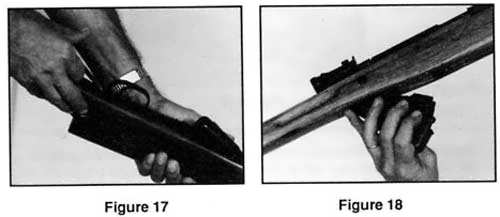
Note: Foreign material in trigger group is a major cause of SKS "Doubling" or "Slam Firing". Trigger group should be cleaned and lubricated regularly.
At this time, receiver barrel stock assembly may be removed.
Removing Receiver Barrel Assembly From Stock
Prior to start, remove trigger mechanism/magazine.
1. Extend bayonet.
2. Lay gun on padded table upside down.
3. With right hand hold rear of receiver assembly tightly against table with screwdriver or punch. With left hand, lift up firmly on stock separating the two pieces (See figure 19)
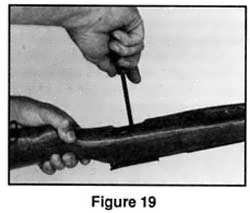
Note: Crossbolt removal is not required or recommended.
Assembly requires only that you perform the above steps in reverse order.
Sight Adjustment
Elevation: Using a front sight elevation tool, insert the forked end of the tool into the top of the front sight hood. Engage the tool into the flats of the front sight post. Turn the tool counter-clockwise to lower the bullet's point of impact on target. To raise the point of impact, turn the tool clockwise.
Windage: Using a small mallet and brass punch, or an after market windage adjustment tool, windage can be adjusted by drifting the front sight seat, in the direction desired. From the perspective of a sight picture, move the front sight seat in the opposite direction you want your point of impact to shift. For example, to move the group on the target to the left, drift the front sight seat to the right.
The rear sight is an open notch type which is adjustable for elevation from 100 metres to 1000 metres (110 years to 1100 yards). There is also an all purpose "battle" setting on the sight ladder, set for 300 metres (330 yards). This is attained by moving the elevation slide to the rear of the ladder as far as it will go.
Mounting the Bayonet
Begin by sliding the bayonet handle and the bayonet spring over the tang of the spike bayonet. Push downward on the handle until the slot for attaching the bayonet screw is exposed. Hold the bayonet carefully in this position with the muzzle ring facing the muzzle of the rifle and insert the bayonet pin into its proper slot in the bayonet lug. Tighten the bayonet pin with a screwdriver of proper size.
Parts Legend SKS
1. Piston
2. Handguard and Gas Cylinder
3. Piston Extension
4. Piston Return Spring
5. Front Sight
6. Front Sight Seat
7. Handguard Catch
8. Bayonet Screw
9. Bayonet Assembly
10. Hold Open Latch Pin
11. Hold Open Latch Spring
12. Hold Open Latch
13. Receiver and Barrel Assembly
14. Takedown Latch
15. Trigger Guard Latch
16. Latch Pin
17. Rear Housing
18. Bolt Carrier
19. Bolt
20. Firing Pin Retainer
21. Firing Pin
22. Extractor Spring
23. Extractor
24. Recoil Spring
25. Spring Retainer
26. Larger Spring Guide
27. Small Spring Guide
28. Stock Assembly
29. Trigger Guard Spring
30. Magazine
31. Magazine Follower
32. Follower Spring
33. Hinge Pin
34. Magazine Cover
35. Cover Latch
36. Latch Spring and Sear Spring
37. Sear
38. Latch Stop Pin
39. Trigger Guard
40. Disconnector Hinge
41. Trigger Pin
42. Safety Catch
43. Safety Catch Spring
44. Trigger
45. Safety Catch Pin
46. Trigger Bar
47. Trigger Bar Pin
48. Trigger Spring
49. Disconnector
50. Rebound Desconnector
51. Hammer
52. Hammer Strut Pin
53. Hammer Strut
54. Hammer Spring
55. Cleaning Rod
